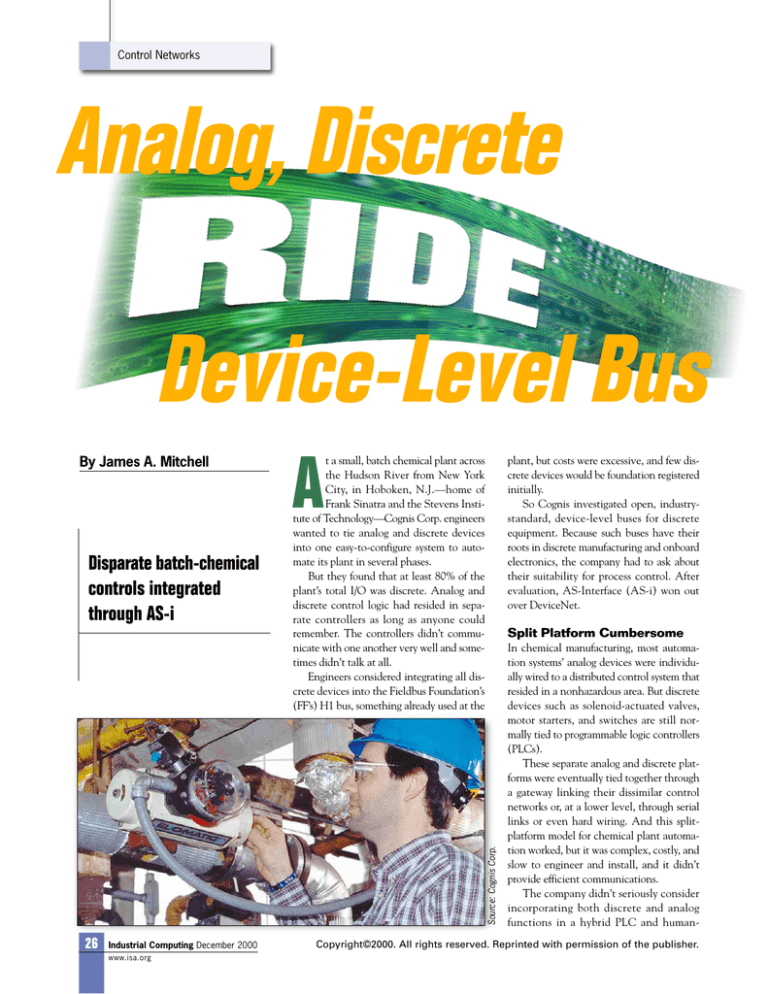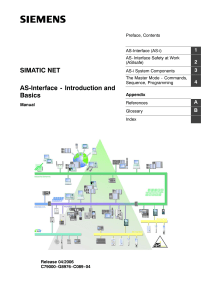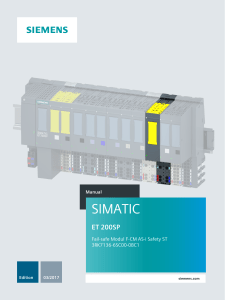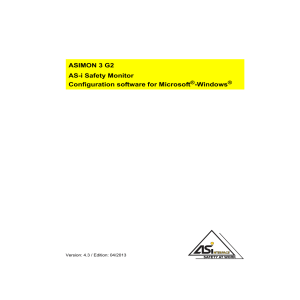
Control Networks
Analog, Discrete
Device-Level Bus
By James A. Mitchell
plant, but costs were excessive, and few discrete devices would be foundation registered
initially.
So Cognis investigated open, industrystandard, device-level buses for discrete
equipment. Because such buses have their
roots in discrete manufacturing and onboard
electronics, the company had to ask about
their suitability for process control. After
evaluation, AS-Interface (AS-i) won out
over DeviceNet.
A
Split Platform Cumbersome
Source: Cognis Corp.
Disparate batch-chemical
controls integrated
through AS-i
t a small, batch chemical plant across
the Hudson River from New York
City, in Hoboken, N.J.—home of
Frank Sinatra and the Stevens Institute of Technology—Cognis Corp. engineers
wanted to tie analog and discrete devices
into one easy-to-configure system to automate its plant in several phases.
But they found that at least 80% of the
plant’s total I/O was discrete. Analog and
discrete control logic had resided in separate controllers as long as anyone could
remember. The controllers didn’t communicate with one another very well and sometimes didn’t talk at all.
Engineers considered integrating all discrete devices into the Fieldbus Foundation’s
(FF’s) H1 bus, something already used at the
26
Industrial Computing December 2000
www.isa.org
In chemical manufacturing, most automation systems’ analog devices were individually wired to a distributed control system that
resided in a nonhazardous area. But discrete
devices such as solenoid-actuated valves,
motor starters, and switches are still normally tied to programmable logic controllers
(PLCs).
These separate analog and discrete platforms were eventually tied together through
a gateway linking their dissimilar control
networks or, at a lower level, through serial
links or even hard wiring. And this splitplatform model for chemical plant automation worked, but it was complex, costly, and
slow to engineer and install, and it didn’t
provide efficient communications.
The company didn’t seriously consider
incorporating both discrete and analog
functions in a hybrid PLC and human-
Copyright©2000. All rights reserved. Reprinted with permission of the publisher.
Control Networks
machine interface control system. That
was because the engineering group didn’t
have the staff or time to develop such a
system from scratch, as a large amount of
development and programming work
would have been required.
Cognis also lacked a global database and
therefore would have needed to do extensive
mapping. Such a system wouldn’t have had
the preengineered functions and scaling that
make process controllers so analog friendly.
The engineers did consider integrating
all discrete devices into FF H1. But they surmised that the cost would be excessive and
that few discrete devices would be registered
by the foundation, at least initially.
Source: Cognis Corp.
Discrete Climbs Aboard
Typical Class 1, Division 2 solenoid valve
controlled by AS-i bus communications.
Cognis began investigating open, industrystandard, device-level buses for discrete
equipment. The goal was to cost-effectively
and seamlessly integrate both analog and discrete buses into a scalable control system to
automate its plant in several phases.
The company evaluated DeviceNet
and AS-i bus and chose the latter. It is a
two-wire, master/slave bus organized in a
tree topology that engineers believed
would provide the best combination of
cost, performance, and features for the
AS-i Offers Simplicity
AS-I bus is based on CENELEC standard EN 50 295. AS-i is
less sophisticated than the FF H1 bus and most other discrete
buses, which explains its lower cost. This robust digital bus
was primarily designed for on/off switching.
An application-specific microchip drives slave
logic and communications for this two-wire,
master/slave bus. It’s organized in a
tree topology with a maximum of 31
slaves per network. Each slave handles up to four sensors or actuators, giving a total of 124 I/O
points. The device interface has
four configurable data ports
(inputs, outputs, or bidirectional),
four parameter outputs, and two
control outputs (strobe).
AS-i bus also provides power for the
sensors and actuators, with a maximum
current of 8 A, or 258 mA per slave for a fully
loaded segment. This will drive low-power, solenoidactuated valves. If substantially more power is needed, AS-i
bus can drive a remote AS-i relay module to switch an auxiliary
power circuit typically rated at 2 A, 24 VDC per output, which is
sufficient to operate motor contactors.
The master automatically assigns an address in sequence
plant’s batch processes. Reportedly, AS-i
detects single and double faults with a certainty of 100% and all threefold and fourfold faults to 99.999%.
The engineering team started small,
automating just one new process expansion. The implementation included control valves, transmitters, on/off valves, and
starter relays. The plant planned to do
later upgrades that would include additional fieldbus devices and 25 AS-i slaves
on one network each. The controller
would also handle hard-wired 4–20 mA
analog devices and discrete devices that
don’t support FF H1 or AS-i bus.
For space and other reasons, Cognis engineers placed the process controller in a cabinet in a motor-control center (MCC) room.
Although the controller itself was certified
for hazardous areas, other electrical and electronic components in the cabinet were not.
Because bus cards take much less space
than hard-wired I/O modules and termination blocks for an equivalent point count,
the controller, when fully loaded, was relatively modest in physical size—and the cabinet relatively clean—for the degree of
control involved.
For ease in troubleshooting and to avoid
clutter, Cognis engineers terminated FF H1
on start-up unless slaves have been preaddressed using a
programming tool. The master polls slaves in order, with each
slave’s traffic in both directions completed before the next
slave is polled. Message structure is compact and transmission fast: 4 bits (net) per slave and message (plus status),
with a maximum cycle time of 5 ms for 31 slaves.
Garbled messages are identified and
repeated.
One of AS-i bus’s advantages for
process control is its acceptance
for classified areas. Discrete valve
communications manufacturers
have been quick to introduce
Class 1, Division 2 AS-i slave
communications packages that
typically control the solenoid and
two limit switches.
The network floats, so it has
excellent noise resistance, enabling
high common-mode rejection.
The primary limitation of AS-i bus is its maximum
drop length of 100 meters, although a repeater can extend
that reach. Plants can avoid the short bus length problem if
a Class 1, Division 2–rated controller can be placed near the
process. Also, discrete devices such as valve manifolds are
often grouped together.
Copyright©2000. All rights reserved. Reprinted with permission of the publisher.
Industrial Computing December 2000
www.isa.org
27
Control Networks
and AS-i segments in dedicated boxes, even
though both segments were carried in the
same conduit. The other segment simply
passed through the box. If the analog or discrete devices served were nearby, a flexible
oil-tight conduit typically routed the spurs
from the junction boxes. The company did
not connect devices in a daisy chain, for
maintenance and troubleshooting reasons.
New Vs. Old
Cognis saw changes or savings in several
areas after combining the analog and discrete systems.
Less wire required. In a traditional
hard-wired system, the number of control
points handled by these digital buses
would have required four to six 1¼-inch
or 1½-inch conduits, with analog and discrete wiring separated.
The AS-i standard allows for a special
molded cable, but Cognis didn’t use it,
opting instead for electrical conduit.
AS-i bus doesn’t require shielded twistedpair wire and can be run in conduit with
other control circuits. So the company
pulled all wire—two twisted-shielded FF
H1 pairs, four AS-i bus conductors (two
networks), two AS-i auxiliary power conductors, and a 16-pair traditional control
cable for future 4–20 mA use—through
one 2-inch sealed conduit from the MCC
room to a junction box in the manufacturing area.
Engineers noticed no signal degradation
or cross talk in either of the buses, even with
the wires carried in the same conduit.
Drawings consolidated. In the past, each
device required a loop diagram. This time
the engineering team used a single diagram
for 25 AS-i slaves and 16 FF H1 devices.
They didn’t need maps of marshaling cabi-
nets and termination boxes, and there were
no wire pair numbers to assign and record.
Fast installation and commissioning. The
Cognis team members found that fewer wires
and terminations helped speed up the
process. They also saved time by not needing
to trace or ring out pairs. And with digital
buses, inadvertent cross pairing can’t occur.
The control system autorecognized FF H1
devices and AS-i bus slaves.
Higher initial cost. Even though AS-i is
a low-cost discrete bus, the cost to connect the first device is higher than the
cost of conventional hard wiring and the
first discrete I/O module. This is true for
most digital bus applications. But as more
slave units are added, the cost per device
goes down. Cognis estimated that the
hardware cost curves for hard-wired and
AS-i bus intersected at about 10 AS-i
slaves per bus.
The company’s initial installation has
worked perfectly since start-up. The plant
collects large amounts of data from the FF
H1 devices and uses the data to monitor and
manage its instrumentation assets. The system detects problems with discrete devices
because failure of any function in an AS-i
device can be alarmed.
The engineering team’s success in applying both analog and discrete buses has
encouraged it to automate the entire plant
using this architecture. The Hoboken plant’s
success is also of great interest to other CogIC
nis plants around the world.
ABOUT THE AUTHOR
James A. Mitchell, P.E., is principal
process engineer at Cognis Corp.’s
Hoboken, N.J., plant. Contact him c/o
editors at IC@isa.org.
Getting Automation Nearer
The introduction of digital fieldbuses and scalable, field-distributable process
controllers has begun changing the architecture of process automation.
Controllers and analog I/O cards rated for Class 1, Division 2 environments now
permit automation to be located
near the equipment controlled. This
minimizes conduit seals between
hazardous and nonhazardous areas.
One pair of the FF H1 can serve
16 analog instruments, carrying a
wealth of data. Windows-based configuration enables autosensing as
devices are installed, reducing
CONTROLLERS WELCOME
commissioning time.
HAZARDOUS
AREA
28
Industrial Computing December 2000
www.isa.org
Digital Control Changes Plant Ops
Just as digital data communications
changed the way organizations perform business, digital communications are changing the way goods
are manufactured.
Less wiring is the most obvious
argument for digital control networks,
but the greatest advantage comes
through utilizing the wealth of information digital control networks provide.
“Once you go digital, you add equipment health data into your system,”
said Jim Gray, director of advanced
development for The Foxboro Co.
“You also get more precise data for
process analysis.”
Systems prioritize equipment
health data so that the most important problems are taken care of first.
Staffers then use asset management software packages to order
parts and generate work orders
before a sensor or valve fails. “One
of our customers reduced its maintenance workload by two-thirds after
going from a hard-wired to a digital
system,” Gray said.
Low-cost device buses for discrete
control offer a significant advantage in
maintenance costs. “The biggest paycheck is in preventing valve-related
breakdowns,” he said. “You can use a
higher-level discrete bus like ProfibusDP or simpler, lower-cost buses like
DeviceNet or AS-Interface.”
And equipment health isn’t the only
advantage.
With digital communications, plant
maintenance staffers can make many
instrument adjustments from safe
environments that would require going
into hazardous areas with a traditional
system.
For process design and control,
more precise process data brings statistical process control to a higher
level, allowing control and process
engineers to boost efficiency through
tuning and process changes.
Equipment manufacturers use
newfound data to improve their products. “Since digital transmitters
came out, we’ve seen great improvements in mean time between failure,” stated Gray.
—Matthew G. Lamoreaux
Copyright©2000. All rights reserved. Reprinted with permission of the publisher.






